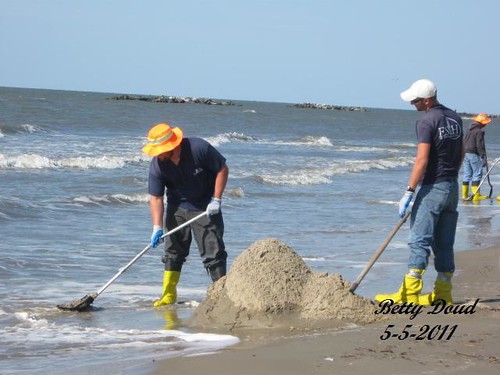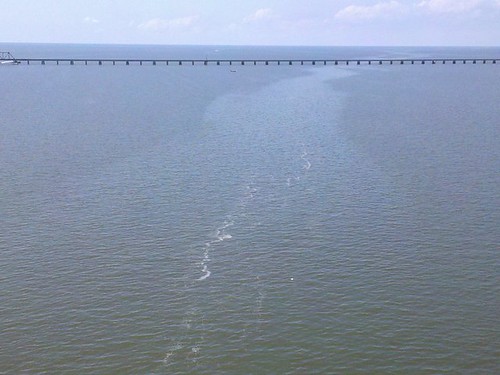The Parallel Universe of the Gulf Oil Threat
There’s a parallel universe in the Gulf these days. In one, the water’s clear, the beaches clean and the seafood's as sublime as ever. The other is the one I witnessed last month, a world many fear may be closer to the truth.
I had been attending a rally—the Big Oil Panty Protest to be exact—in Grand Isle, ground zero for the BP oil assault and a spit of sand and beach town sticking out from Louisiana’s most southern coast. It was a beautiful Gulf morning when I decided to take a walk on the beach at Grand Isle State Park. The sand was warming and the ocean water was muddy but calm. A flock of seabirds gathered on a nearby sandbar. Except for an orange plastic fence blocking off part of the beach, all appeared normal. Several families and their children had plopped down their towels and umbrellas. The kids eagerly jumped in the waves.
But the beach scene was soon to change. A uniformed park ranger packing a 9 mm pistol and a broad-brimmed hat marched through the sand towards us, clearly on a mission. “Excuse me but everyone here needs to get off the beach,” he barked. “This beach is closed.”
The family vacationers approached the officer incredulously. “Why,” they asked. “We just got here. There aren’t any signs?”
“The beach is closed because there’s still oil and tar balls coming in,” the officer said in a polite but stern voice. “It’s not safe to be here.”
The families grudgingly packed up their beach gear, grabbed their kids and trudged back to their cars. “It looks fine to me,” one mother said. “It doesn’t seem right.”
But it was right. The officer told me later there were tar balls everywhere on the beach the day before. Locals say there are huge mats of hardened oil on the seabed just off the shoreline, pieces of which wash in with the tides daily. Locals take pictures of dead birds and animals they say they’ve never seen before, and those are just the ones the beach crews miss when they comb the area every morning.


Beach cleanup crews and tar balls on Grand Isle this month Photos: Betty Doud
In Grand Isle, people swim in the waters often oblivious to the oily tar balls that wash in around them. It’s like that across the Gulf. Everyone hopes for a clean rejuvenated ocean this year, a return to normalcy for those who’ve suffered a world of hurt after BP’s historic blowout. The tourist industry and government officials are hard at work pushing this vision through major ad and PR campaigns.
But it’s far from the real world. Scientific investigations are moving through the painstaking process of analyzing the impacts of 170 million plus gallons of oil that spewed into the sea. Although it will be years before the full effects are known, some researchers are already seeing some disturbing findings. Recently scientists discovered lesions in red snapper they are investigating as having possible links to the oil. Here’s what the Pensacola News Journal reported last weekend:
In the years following the 1989 Exxon Valdez oil spill in Alaska's Prince William Sound, the herring fishery collapsed and has not recovered, according to an Exxon Valdez Oil Spill Trustee report. The herring showed similar signs of illness — including skin lesions — that are showing up in Gulf fish.
Worried that same scenario could play out along the Gulf Coast, Patterson is conducting research on the chronic effects of the BP oil spill on Gulf fish. And he sees troubling signs consistent with oil exposure: fish with lesions, external parasites, odd pigmentation patterns, and diseased livers and ovaries. These may be signs of compromised immune systems in fish that are expending their energy dealing with toxins, Patterson said.
"I've had tens of thousands of fish in my hands and not seen these symptoms in so many fish before," said Patterson, who has been studying fish, including red snapper, for 15 years. "All those symptoms have been seen naturally before, but it's a matter of them all coming at once that we're concerned about."
As high numbers of endangered sea turtles and dolphins have washed into the beaches Mississippi and Alabama beaches in recent months, residents continue combing the beaches on their own, documenting what they’re finding.
In recent days, Charles Taylor was driving near Bay St Louis when he noticed what appeared to be a sheen of oil stretching out for miles. He snapped a few shots with his cell phone camera and went down to get a closer look. “Must be chocolate, because the oil’s all gone,” he wrote on his Facebook page.


What appears to be oil near Bay St Louis, MS Photos: Charles Taylor
But the oil’s not gone. Some beaches are not being cleaned due to concerns about interrupting spring nesting patterns for seabirds and turtles. The tar balls are piling up in places that have some local residents alarmed. Here’s what Alabama resident Lisa Hansen, a member of the Dauphin Island Town Council, told the Press Register this weekend;
“I’ve got a 5 gallon bucket of them in my garage. The tar balls ranged from pea-size to a really big hamburger,” Hansen said. “BP has not done what they said they would do. It’s still out there on the beach and it is being moved by the waves. That means it can get into Mobile Bay and the Mississippi Sound, into our estuaries and all those places we don’t want it to get to.”
Paul Orr and the Mississippi Riverkeepers have been testing along the coasts of Louisiana for nearly a year now. He described an area of barrier islands and part of the national wildlife seashore he visited in March this way:
By the time we made it to Breton Island the skies had cleared and the sun was shining brightly. The island was alive with spectacular flocks of birds. The spring bird migration is in full swing in coastal Louisiana. Unfortunately the birds were sharing the island with oil. Long trails of heavily oiled sand and scattered tar balls were found spread along the center of the island. The larger oil “patties” were 10 to 12 or more inches in diameter and looked like dark brown sugar with extra molasses mixed in on the inside but smelled like tar.
These are the images and reports BP and the tourist industry doesn’t talk about much. Most tourists have no idea there are 4,000 oil spills a year in the Gulf. Locals say it’s hard to know when beaches are closed and that many aren’t well marked. These problems are not headline news in most coastal tourist towns right now. They are world's apart.
But the size and stakes of this oil threat are still as big as they’ve ever been. At this point, it's hard to say which parallel universe will emerge on top.
